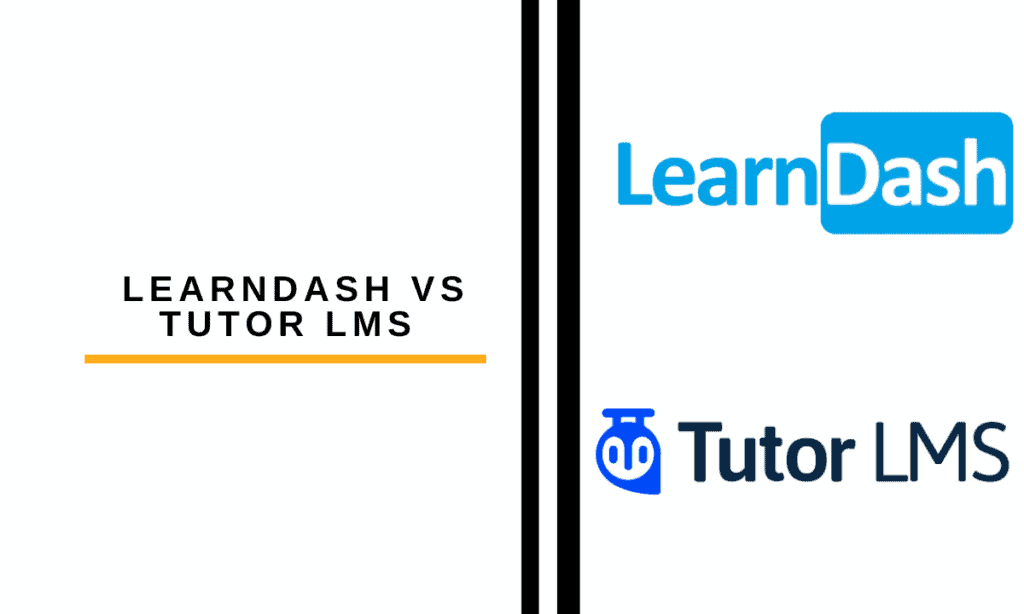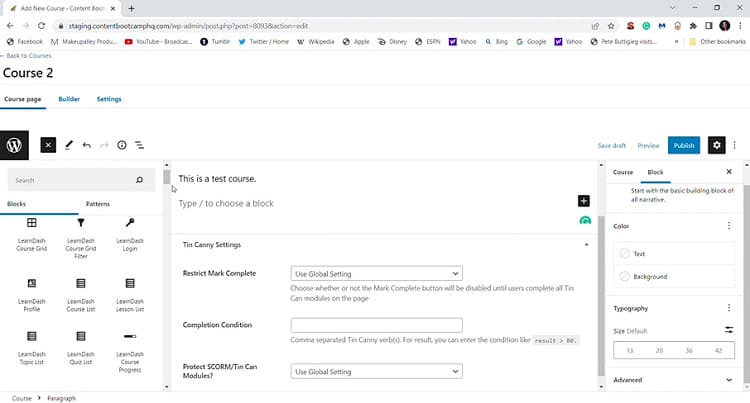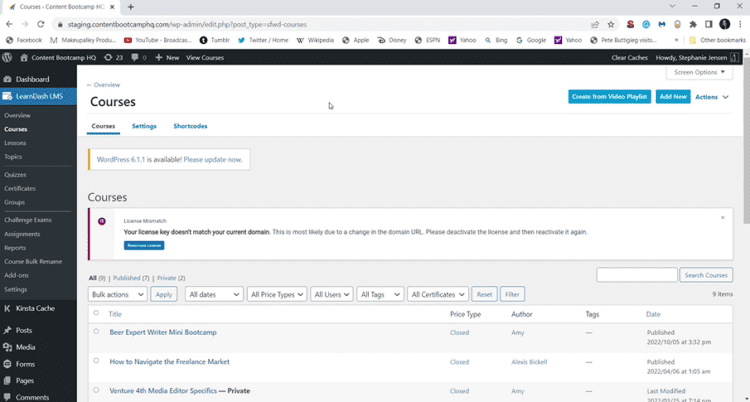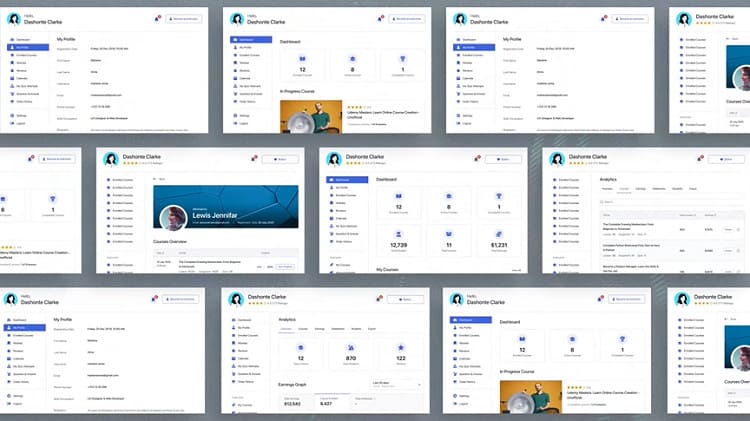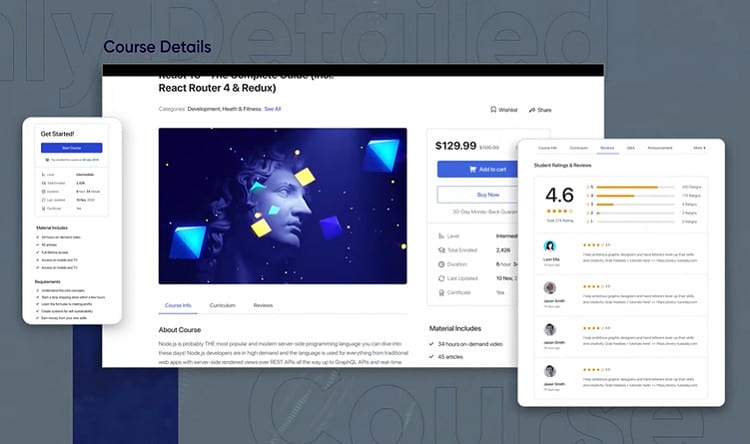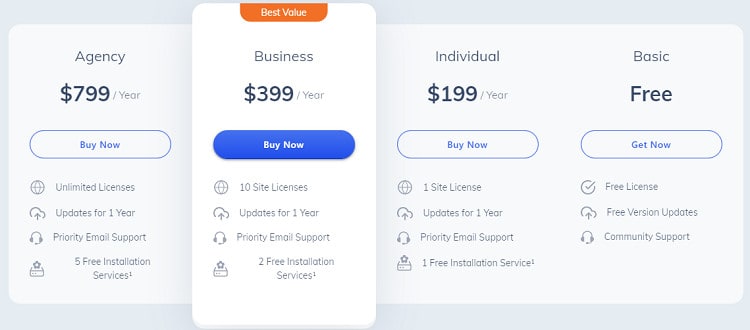Last Updated on June 1, 2023 by Ewen Finser
If you want to create courses, you have many LMS options. LearnDash is a famous one, but it’s also similar to Tutor LMS. Both are WordPress plugins that let you create and manage courses directly on the website’s backend. But there are some differences between the two platforms, and one may be a better option for you.
I’ve been a LearnDash user for years, but there are very appealing aspects of Tutor LMS. In this guide, I’m using both platforms to see which one I recommend. Read my compare LearnDash vs Tutor LMS guide to discover which one you should be using.
Bottom line up front
The most trusted WordPress LMS plugin, created by learning industry professionals with Fortune 500 experience. Transform your site in less than 5 minutes.
The Main Differences Between LearnDash cs Tutor LMS
- Tutor LMS offers a free plan, whereas LearnDash doesn’t
- LearnDash has been trusted for years, whereas Tutor LMS is new
- LearnDash uses more plugins, whereas Tutor LMS has more built-in features
- You need WordPress experience to navigate LearnDash, whereas Tutor LMS is more straightforward
LearnDash
LearnDash has been my go-to LMS for a long time. This LMS offers everything you need to make an impressive course. If there’s a function that LearnDash doesn’t support, you can always add one of the many plugins that integrate with LearnDash. This is why LearnDash has been a trusted LMS for years.
Pros
- Suite of features
- Several plugins, integrations, and add-ons
- SCORM compliant
Cons
- Expensive
- No free plan
Features
LearnDash has a long list of features, and it would be impossible to list them all here. The major features include:
- Lessons
- Quizzes
- eCommerce
- Compliance
- Custom development
- Marketing
- Memberships
But just because LearnDash offers these features doesn’t mean they’re quality. For example, I find their membership platform difficult to use. If LearnDash doesn’t offer a feature you need, they integrate with a suite of plugins, which I will discuss later.
Bottom line: LearnDash offers many impressive features to create and manage courses, promote them, and handle any eCommerce. However, I don’t like all of their features, such as the memberships.
Course Creation and Management
LearnDash offers everything you need to create a high-quality course. As a WordPress plugin, LearnDash supports various content types, lessons, quizzes, advanced features such as drip-feed lessons, and more. LearnDash’s course scheduling feature stands out, so you can automatically deliver lessons to students.
My problem with LearnDash is you need WordPress experience to create a course. Instructors must jump around to different pages to create the course content and different settings. If you’re new to WordPress, I suggest learning WP first.
Bottom line: LearnDash offers many advanced features and content options to create exceptional courses. The only problem is LearnDash can be hard to navigate, so this is a better option for experienced WordPress users.
The most trusted WordPress LMS plugin, created by learning industry professionals with Fortune 500 experience. Transform your site in less than 5 minutes.
Support
I’ve been using LearnDash for a long time, and there have been moments when I ran into issues. Unfortunately, I don’t think LearnDash’s support is as effective as it should be. For example, I had an issue setting up a membership subscription. I tried using their video tutorials and reading their blog, but neither source helped me solve my problem. I had to find a random tutorial on YouTube to sold my problem.
With that being said, I never contacted their customer service. My colleagues say their customer service is solid. They also have online forums and a massive community of users, and I’ve found many tutorials on one of their many community forums.
Bottom line: Their knowledge center isn’t the best, and I don’t think their content is helpful. However, they have solid customer service, and you can find various community forums online.
Ease of Use
I’ll repeat the information mentioned in the course creation section–LearnDash is easy to use if you’re familiar with WordPress. Since LearnDash is a WordPress plugin, most of your functionality will be on the WP backend. If you’ve used WordPress, you won’t experience as much of a learning curve.
I wish LearnDash’s course creation structure was more straightforward, which will confuse new users. I’ve been using WordPress for 10 years, so I was able to get around this quickly.
Otherwise, nearly all of LearnDash’s other functions are easier. You can easily manage your courses and plugins from the backend, and everything is accessible via the left-hand menu bar.
Bottom line: If you’re familiar with WordPress, LearnDash is easy to use. But if you’re new to WordPress, jumping around LearnDash’s different navigational structures will confuse users.
Integrations
The integrations and plugins are where LearnDash shines. Even though this platform comes with many built-in features, you can access a whole plugin library, and most of these add-ons are available for free. You can view a full list of their add-ons here.
My favorite add-ons are the gamification ones, such as LearnDash Achievements. Gamification applies a game-like element to your course, making learning fun. LearnDash Achievements applies points to lessons and quizzes completed, and your students receive badges.
If you’re selling your course, LearnDash also supports integrations with WooCommerce, giving you more eCommerce tools. I also recommend all instructors download Stripe to accept all major credit cards and currencies.
Bottom line: LearnDash offers advanced plugins, integrations, and add-ons to enhance course functionality. I love the eCommerce tools and how you can make your course a game.
eCommerce
As stated previously, LearnDash offers many eCommerce integrations. You can extend eCommerce functionality with WooCommerce, SamCart, and ThriveCart, and extend your payment processing with Stripe (newer versions of LearnDash have Stripe built-in). If you prefer a membership subscription, I suggest using a third-party plugin such as PaidMembershipsPro over LearnDash’s built-in functions.
Bottom line: LearnDash offers various eCommerce built-in features and plugins to better sell your course. You can offer membership subscriptions, though I suggest using a plugin over their built-in memberships.
Pricing
My big problem with LearnDash is the pricing. First, LearnDash is expensive. Their one-website license starts at $199/year, which is more expensive than most competitors. If you want to host more websites, this price increases. Unlike Tutor LMS, LearnDash doesn’t offer a free plan. They don’t even offer a free trial, just a demo.
Bottom line: LearnDash is more expensive than the competition, doesn’t offer a free plan, and only offer a demo over a trial.
Tutor LMS
Tutor LMS is a similar WordPress plugin, but there are some key differences here. It offers a free plan and has a straightforward course creation system, but it does lack in some areas where LearnDash thrives.
Pros
- Free plan
- Simple to use
- A good option for those new to WordPress
- Lifetime license options
Cons
- No compliance
- Lacks plugins and add-ons
- No support
Features
Tutor LMS offers the same basic features as LearnDash. You can build a great course, and many themes also work with Tutor LMS.
Students can receive notifications and emails. However, the features don’t extend further than this. Tutor LMS is the better option if you want to create a simple course or are new to building courses.
Bottom line: Tutor LMS offers the basic features to create a high-quality course, but it doesn’t offer the advanced features that LearnDash boasts.
Course Creation and Management
Even though Tutor LMS doesn’t offer the features that LearnDash offers, I like the course creation much better than in LearnDash.
Tutor LMS is very user-friendly and puts you through an entire prompt to create your course. The structure is very straightforward, and you don’t have to jump through different pages as you do with LearnDash.
Tutor LMS has a similar hierarchy as LearnDash. The hierarchy is as follows:
- Course
- Topic
- Lesson
- Quiz
I wish there was more flexibility, but it is easy to stay organized. You can create your course in the backend or upload your course by using an uploader plugin, such as Mammoth Docx Converter.
I especially love the different quiz content options–you can choose matching images and open-ended responses, something that many competitors don’t offer.
Once you follow the prompts, you can preview your course before publishing it. I suggest doing this to ensure it looks and functions well on the student’s side.
Bottom line: Tutor LMS’ course creation is more straightforward than LearnDash’s. You still get powerful features, such as more diverse quizzes.
Support
Tutor LMS doesn’t have terrible support. For example, they have an excellent demo that takes you through every step of the course creation process.
The developer is Themeum, and they offer a knowledge base, email, and chat support. I haven’t contacted their customer service yet, so I can’t review this. But I was looking around their knowledge base, and the content they offer is generally good information content, but it doesn’t offer tutorials. And since Tutor LMS isn’t as popular as LearnDash, you don’t receive the community features such as a forum.
They could use content and a community to enhance their customers’ knowledge of the platform, and Tutor LMS is missing a big opportunity here.
Bottom line: Tutor LMS offers a great demo to navigate their plugin, but that’s it. They’re missing a big opportunity by not offering a community forum and more tutorials in their knowledge base.
Ease of Use
As I said before, Tutor LMS is super simple to use. Their plugin is very straightforward, and the course creation process is structured better than LearnDash’s. Because of this, Tutor LMS is the better option for new course creators and WordPress users.
I especially love the tutorials and demos they offer, which will help you learn their backend even more quicker. I wish the lesson content view was larger, like a traditional WordPress blog, but that’s only a nitpicky problem. Overall, I had a better experience creating a Tutor LMS course than a LearnDash course.
Bottom line: Tutor LMS is very easy to use and is the better option for beginners.
Integrations
Tutor LMS offers limited integrations on the free plan, which is a shame since this platform doesn’t offer LearnDash’s robust features. They only offer the basic features to create a course and get paid.
I noticed Tutor LMS integrates with Mammoth Docx Converter, Elementor, WooCommerce, and a few others. If you want advanced integrations, such as with BuddyPress or Zoom, you’ll have to pay. Though I like their advanced quiz creator, it doesn’t amount to the functionality that LearnDash offers.
Bottom line: Tutor LMS offers some integrations with the free plan, but not close to the number that LearnDash offers. If you want more integrations on Tutor LMS, upgrade to a paid plan.
eCommerce
Tutor LMS offers built-in payment features, such as PayPal. The free plan also integrates with WooCommerce. There are more eCommerce integrations if you upgrade your plan, but you’re limited on the free plan. On the free plan, Tutor LMS will also take a percentage of your earnings.
Bottom line: Tutor LMS offers some built-in eCommerce features and integrations on the free plan, but you’ll have to upgrade if you want more. Plus, Tutor LMS will take a percentage of your earnings on the free plan.
Pricing
Tutor LMS shines because of its free plan. Even though the free plan has limited features, it’s a good option for new course creators and those who only want a simple course. Otherwise, the free plan has no time limits or other constraints, except how Tutor LMS will take a portion of your earnings.
If you want a paid course, you’ll be paying the same amount as LearnDash–the first tier is $199/year, and the price increases if you want more websites. I also love how Tutor LMS offers a lifetime price. I’m not a fan of subscription pricing and would rather pay one cost for everything.
Bottom line: Even though Tutor LMS is the same price as LearnDash, they offer a free plan and lifetime pricing. I like this level of flexibility, especially since they have a free plan.
Alternatives
Did you finish this guide and realize neither Tutor LMS nor LearnDash is right for you? Here are some more alternatives to consider.
Matrix LMS
Matrix LMS is a platform for businesses that want to host their own employee training. Companies can build, manage, and deliver training activities to all employees with ease.
I find their platform is very stable with few crashes. I can’t say the same thing about the app; while I like how they offer a mobile training option, the app doesn’t work very well. I also think Matrix LMS’ design is a little outdated.
But there are many good qualities of this platform. For example, you also have many course options and learning paths. Plus, they have excellent customer support.
Udutu
Udutu is another platform perfect for first-time course creators and small businesses. First, they have some of the best pricing options.
They not only have a free plan, but their paid plans are extremely affordable. Though their advanced plans go up to the thousands, the standard plans only cost a few dollars per month. If you have less than 1,000 users on your course, you can only expect to spend around $12/per year.
Their LMS has a learning curve, and I don’t think Udutu has the best support. I suggest using the free plan before paying for this service.
SmarterU LMS
SmarterU LMS is one of the most advanced LMS platforms I’ve heard of. They have advanced grading capabilities, and their entire backend is easy to use, and it loads quickly. If you ever have any issues, their support is responsive and helpful. The only downside is the pricing.
Plans start at $7K/year, which is even more expensive than LearnDash. That’s why I only recommend this platform to enterprises that need advanced training solutions.
FAQs
Question: Is Tutor LMS SCORM-compliant?
Answer: No, but LearnDash is.
Question: Is LearnDash Right for me?
Answer: LearnDash is a flexible LMS. I only used it to host simple writing courses, but it’s also used by universities, companies, entrepreneurs, and other training organizations.
Question: Do I need WordPress for these Plugins?
Answer: LearnDash offers cloud-based LMS, so you don’t need a WordPress account. Tutor LMS can integrate with Cloudways to host it on the cloud.
Bottom Line
This is a tie. Both LearnDash and Tutor LMS are high-quality LMS platforms, but both are better solutions for different course creators.
If you’re a new course creator and WordPress beginner, I suggest using Tutor LMS. Their platform is easy to use, and they offer a free plan.
If you’re ready to upgrade, LearnDash is a trusted LMS with more features and integrations. LearnDash’s paid plans are also the same price as Tutor LMS’, so your dollars will go a long way. If you don’t think either provide what you need, I suggest checking out my alternatives.
The most trusted WordPress LMS plugin, created by learning industry professionals with Fortune 500 experience. Transform your site in less than 5 minutes.

